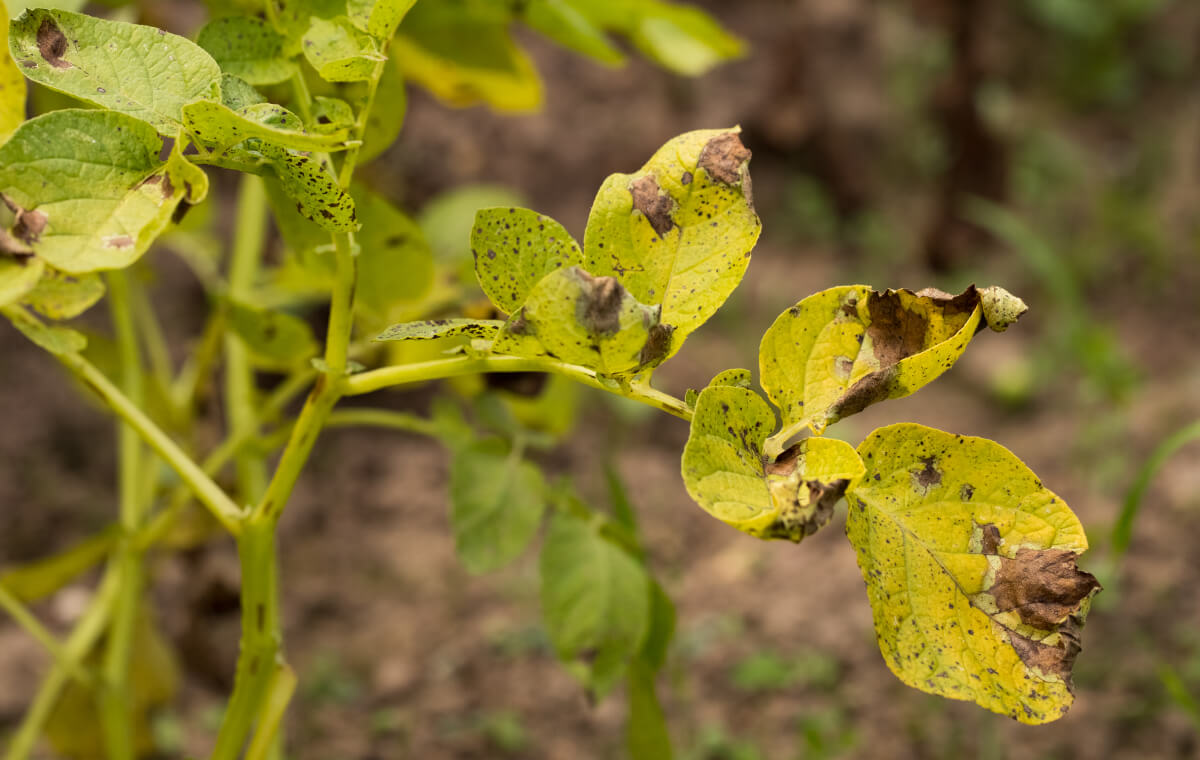
Early Blight Or Alternariosis
Alternaria Solani / Alternaria Alternata
Pathogen:
Fungus
Type:
Risk:
HIGH
Alternariosis
Patata


WHO CAUSES IT?
Alternaria solani and Alternaria alternata are phytopathogenic fungi that cause the disease known as early blight or alternariosis in potatoes. These fungi produce spores that spread through air, water and soil, infecting potato plants primarily in warm, humid conditions. The fungus can survive in soil and infected plant remains for long periods. During the growing season, spores can infect potato leaves, stems and tubers, causing significant damage.
SYMPTOMS
Early blight or alternariosis produces lesions on the leaves, stems and tubers of the potato. On leaves, symptoms include dark, concentric Taches, which can cause premature defoliation. On the stems, the fungus can cause lesions and weaken the plant. In tubers, infections can cause rot and reduce the quality of the crop.
• Dark, concentric Taches on the leaves.
• Injuries to the stems and weakening of the plant.
• Rot and lesions on the tubers.
• Premature defoliation and reduction in crop quality.


TEMPERATURE AND HUMIDITY
20°C - 30°C
80% - 100%
TRANSMISSION PATHS
Spores carried by air, water, soil, infected plant remains, contaminated growing tools.
Do you want to remove this pest? Choose how you want to treat it.
TREATMENTS
Chemical treatment
• AZOXISTROBIN 25% [SC] P/V
• CYMOXANIL 2.85% + FOSETIL-AL 30% + COPPER OXYCHLORIDE 16% (EXPR. IN CU) [WG] P/P
• CYMOXANIL 3% + CUPROCALCIC SULFATE 22.5% (EXPR. IN CU) [WP] P/P
• CYMOXANILE 4% + FOLPET 25% + FOSETIL-AL 50% [WG] P/P
• DIFENOCONAZOLE 1.67% [EC] P/V
• DIFENOCONAZOLE 25% [EC] P/V
• FOLPET 10% + CUPROCALCIC SULFATE 20% (EXPR. IN CU) [WP] P/P
• FOLPET 50% [SC] P/V
• FOLPET 80% [WG] P/P
• CUPRIC HYDROXIDE 13.6% (EXPR. IN CU) + COPPER OXYCHLORIDE 13.6% (EXPR. IN CU) [SC] P/V
• CUPRIC HYDROXIDE 20% (EXPR. IN CU) [WG] P/P
• CUPRIC HYDROXIDE 50% (EXPR. IN CU) [WP] P/P
• Mandipropamide 25% + DIFENOCONAZOLE 25% [SC] P/V
• METALAXIL 8% + COPPER OXYCHLORIDE 40% (EXPR. IN CU) [WP] P/P
• METIRAM 70% [WG] P/P
• COPPER OXYCHLORIDE 25% (EXPR. IN CU) [WG] P/P
• COPPER OXYCHLORIDE 30% (EXPR. IN CU) [WP] P/P
• COPPER OXYCHLORIDE 35% (EXPR. IN CU) [WG] P/P
• COPPER OXYCHLORIDE 37.5% (EXPR. IN CU) [WG] P/P
• COPPER OXYCHLORIDE 38% (EXPR. IN CU) [SC] P/V
• COPPER OXYCHLORIDE 50% (EXPR. IN CU) [WG] P/P
• COPPER OXYCHLORIDE 52% (EXPR. IN CU) [SC] P/V
• COPPER OXYCHLORIDE 70% (EXPR. IN CU) [SC] P/V
• COPPER OXYCHLORIDE 70% [SC] P/V
• CUPROCALCIC SULFATE 20% (EXPR. IN CU) [WG] P/P
• CUPROCALCIC SULFATE 20% [WP] P/P
• TRIBASIC COPPER SULFATE 19% (EXPR. IN CU) [SC] P/V
• ZOXAMIDE 5.88% + COPPER OXYCHLORIDE 25% (Exp. in Cu) [WG] P/P
Authorized treatments in organic farming
• CUPRIC HYDROXIDE 13.6% (EXPR. IN CU) + COPPER OXYCHLORIDE 13.6% (EXPR. IN CU) [SC] P/V
• CUPRIC HYDROXIDE 20% (EXPR. IN CU) [WG] P/P
• CUPRIC HYDROXIDE 50% (EXPR. IN CU) [WP] P/P
• COPPER OXYCHLORIDE 25% (EXPR. IN CU) [WG] P/P
• COPPER OXYCHLORIDE 30% (EXPR. IN CU) [WP] P/P
• COPPER OXYCHLORIDE 35% (EXPR. IN CU) [WG] P/P
• COPPER OXYCHLORIDE 37.5% (EXPR. IN CU) [WG] P/P
• COPPER OXYCHLORIDE 38% (EXPR. IN CU) [SC] P/V
• COPPER OXYCHLORIDE 50% (EXPR. IN CU) [WG] P/P
• COPPER OXYCHLORIDE 52% (EXPR. IN CU) [SC] P/V
• COPPER OXYCHLORIDE 70% (EXPR. IN CU) [SC] P/V
• COPPER OXYCHLORIDE 70% [SC] P/V
• CUPROCALCIC SULFATE 20% (EXPR. IN CU) [WG] P/P
• CUPROCALCIC SULFATE 20% [WP] P/P
• TRIBASIC COPPER SULFATE 19% (EXPR. IN CU) [SC] P/V
Biological control
• BACILLUS AMYLOLIQUEFACIENS (strain FZB24) 13% [WP] P/P
• BACILLUS AMYLOLIQUEFACIENS (MBI 600 strain) 11% [WP] P/P
• BACILLUS SUBTILIS (STRAIN QST 713) 1.34% [SC] P/V
Recommendations
• Use potato varieties resistant to Alternaria solani and Alternaria alternata.
• Apply specific fungicide treatments in the critical phases of plant development.
• Avoid excess moisture in the soil and foliage, as it favors the development of fungi.
• Improve ventilation in the crop through pruning and proper spacing management.
• Remove and destroy the remains of infected plants to reduce the presence of spores in the field.
• Carry out crop rotation with non-host plants to reduce the persistence of fungi in the soil.
Sponsored link
Sponsored link
Sponsored link
Sponsored link
Sponsored link
Sponsored link
Effective against all types of fungi
TREATMENTS
Homemade treatments
There are no home treatments
Natural allies
Chemical treatments
There are no treatments for this disease. Treatments are directed at the insect vectors that transmit it. See insect treatments.
RECOMMENDATIONS
- Check the back of the leaves frequently, especially in dry weather.
- Spray water on the leaves to increase humidity and prevent them from settling.
- Keep plants healthy with good watering and adequate light.
- If you see cobwebs or damage, clean the leaves with a damp cloth or pressurized water.
- Use potassium soap or neem oil every few days until they disappear.
REPELLENT PLANTS
Rosemary, Dill, Coriander
RECOMMENDED PRODUCTS TO ELIMINATE THIS PEST
Sponsored link
Sponsored link
Sponsored link
Sponsored link
Sponsored link
Sponsored link
Effective against all types of fungi
*The recommended treatments are still recommendations according to the databases of the authorities and at no time do they replace the guidelines established according to the legislation of each country
*The products shown are recommendations and are not our own products. As Amazon Associates, we earn revenue from purchases of recommended products.






















